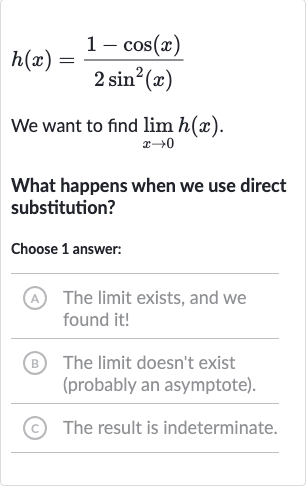AI tutor
Welcome to Bytelearn!
Let’s check out your problem:

We want to find .What happens when we use direct substitution?Choose answer:(A) The limit exists, and we found it!(B) The limit doesn't exist (probably an asymptote).(C) The result is indeterminate.
Full solution
Q. We want to find .What happens when we use direct substitution?Choose answer:(A) The limit exists, and we found it!(B) The limit doesn't exist (probably an asymptote).(C) The result is indeterminate.
- Direct Substitution: Given the function , we want to find the limit as approaches . Let's start by using direct substitution to see what happens when we plug in into the function.Direct substitution: Calculate the values of cosine and sine at . and Substitute these values into the function.
- Indeterminate Form: The result of the direct substitution is , which is an indeterminate form. This means that we cannot determine the limit by direct substitution, and we need to apply other techniques to evaluate the limit.
- Using Trigonometric Identities: Since we have an indeterminate form, we need to manipulate the expression to find a way to evaluate the limit. One common technique is to use trigonometric identities to simplify the expression. We can use the identity to rewrite the denominator.Rewrite the function using the identity.Simplify the expression.
- Correcting the Identity: We made a mistake in the previous step. The correct identity for is not , but rather . We need to correct this and use the correct identity to simplify the expression.
More problems from Write and solve inverse variation equations
QuestionGet tutor help
QuestionGet tutor help
QuestionGet tutor help
Question
In the given equation, is a constant. If the equation has the solutions and , what is the value of ?
Get tutor help